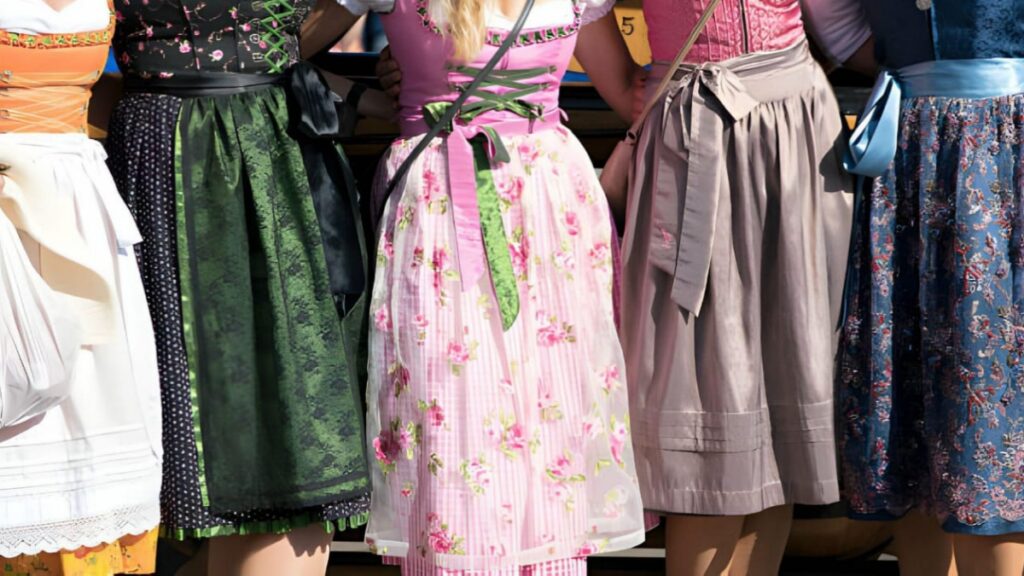Germany is renowned for its rich cultural traditions, and among its most charming symbols is the dirndl dress. This iconic garment isn’t just a pretty outfit; it’s a vibrant piece of history that embodies centuries of tradition, regional pride, and cultural identity. The dirndl dress, with its distinctive design and deep-rooted heritage, serves as a fascinating window into German history and customs. The dirndl dress is more than a mere garment; it’s a key element of festive occasions and cultural celebrations in Germany. If you’re curious about exploring this traditional German dress further, you’ve come to the right place. In this guide, we’ll explore the dirndl dress in depth, uncovering its historical evolution, cultural significance, and how it has adapted to modern fashion. We’ll look at how this traditional German dress has transformed from humble beginnings to a fashion statement embraced around the world. By delving into the story behind the dirndl, you’ll discover why this enduring piece of attire continues to captivate and charm people of all ages. Whether you’re fascinated by its historical roots or intrigued by its contemporary appeal, the dirndl dress offers a rich and colorful tapestry of German heritage.
What is a Dirndl Dress?
The dirndl dress is a traditional German outfit celebrated for its distinctive and charming design. Typically consisting of a fitted bodice, a full skirt, a blouse, and often an apron, the dirndl is most famously associated with Bavaria. However, its origins and variations extend across several regions in Germany and Austria. Initially, the dirndl was practical everyday wear for women and girls in rural areas, designed for comfort and functionality. Over time, it evolved into a vibrant symbol of festivity and regional pride, prominently featured at events like Oktoberfest and various folk festivals. The classic dirndl dress is composed of several key elements. The bodice (Mieder) is snug, with a low neckline that accentuates the waistline, and often includes intricate embroidery or decorative lacing. The skirt (Rock) is full and gathered at the waist, providing ample movement and comfort, and typically falls to knee-length or below. Worn underneath the bodice, the blouse (Bluse) is usually made of white or pastel fabric and may feature puffed sleeves or lace details. The apron (Schürze), which is tied around the waist, can be crafted from either contrasting or matching fabric. It adds a layer of elegance and is frequently decorated with lace or ribbons. Together, these components create a garment that is not only visually striking but also rich in cultural significance. The dirndl dress continues to captivate people around the world, celebrating German heritage and showcasing the enduring charm of traditional attire.
The Dirndl Dress in History
To truly appreciate the dirndl dress, it’s essential to explore its historical roots. Originating in the alpine regions of Germany and Austria, the dirndl dress was initially worn by peasant women and designed for the practical demands of agricultural life. Its simple and functional design catered to the daily needs of rural communities, offering both comfort and utility. However, as social and fashion trends evolved, so did the dirndl. By the early 19th century, the garment began to transition from utilitarian workwear to a symbol of regional identity. This period saw the dirndl adorned with more elaborate decorations, reflecting its growing significance beyond mere practicality. The late 19th and early 20th centuries marked a pivotal shift as the dirndl solidified its role as a staple at folk festivals and celebrations. The dirndl’s transformation was also influenced by the romanticized view of rural life, which emphasized its quaint and picturesque qualities. As it became associated with Bavarian pride, the dirndl dress was embraced as a national symbol during various cultural and historical events. Today, it stands as a testament to German cultural heritage, illustrating how traditional attire can evolve while retaining its historical significance. This evolution highlights how the dirndl has come to represent both a rich cultural legacy and a dynamic piece of fashion history.
The Cultural Significance of the Dirndls
The dirndl dress holds profound cultural significance in German-speaking regions, serving as a marker of regional identity with distinct styles and colors across different areas. In Bavaria, dirndls are typically adorned with vibrant colors and elaborate embroidery, often featuring motifs related to nature and local folklore. In contrast, Austrian dirndls tend to have a more subdued and conservative design, focusing on simplicity and elegance, with high-neck blouses and more restrained skirt lengths. Swiss dirndls incorporate unique elements of Swiss traditional dress, showcasing specific patterns and colors that reflect Swiss cultural symbols. Each regional variation adds unique touches that highlight local customs and traditions. Today, the dirndl dress is more than just a historical garment; it is a living symbol of German culture and regional pride. It remains a prominent feature at festivals like Oktoberfest, where people from around the world gather to celebrate Bavarian traditions with enthusiasm. The dirndl’s enduring appeal is also evident in its presence on fashion runways and global events, demonstrating its continued relevance and adaptability. By embracing both traditional and modern elements, the dirndl dress bridges the past and present, celebrating its rich heritage while evolving with contemporary fashion trends. This ongoing relevance underscores the dirndl’s role as both a cultural emblem and a dynamic piece of attire in the modern world.
How to Wear a Traditional Dirndl Dress
Wearing a dirndl dress correctly involves more than simply donning the outfit; it requires attention to specific rules and customs that enhance the garment’s traditional significance. One of the most intriguing aspects is the placement of the apron ties, which can reveal the wearer’s marital status. For instance, a bow tied on the left side signifies that the wearer is single, while a bow on the right indicates that the wearer is married or otherwise taken. A bow tied in the back typically denotes that the wearer is a widow or in mourning. Beyond the apron, accessorizing plays a crucial role in completing the dirndl look. Traditional jewelry, such as necklaces with heart-shaped pendants or brooches featuring regional motifs, adds a personal touch. Headwear, including hats or floral headbands, complements the dirndl’s design and enhances its festive appearance. Footwear is also an important consideration; comfortable shoes with a vintage or rustic flair are chosen to align with the dirndl’s overall aesthetic. Each of these elements contributes to the dirndl’s rich cultural expression, ensuring that it is worn with both respect for tradition and a sense of style. By paying attention to these details, wearers not only honor the historical and cultural significance of the dirndl dress but also embrace its role as a vibrant symbol of regional heritage.
The Dirndl Dress and Oktoberfest
One of the most famous associations with the dirndl dress is its central role in Oktoberfest, the world-renowned beer festival held annually in Munich, Germany. Oktoberfest is a grand celebration of Bavarian culture, and the dirndl dress is a key element of the festivities. During this vibrant event, dirndl dresses are worn by both women and men, although men’s attire, known as lederhosen, is distinct from the dirndl. The festival is a lively showcase of Bavarian traditions, featuring folk music, dance, and, of course, an abundance of beer. The dirndl dress enhances the festive atmosphere with its colorful patterns and traditional designs, adding to the celebration’s charm. In addition to traditional dirndls, modern adaptations have become popular, reflecting contemporary fashion trends while maintaining a connection to heritage. Designers have introduced updates such as shorter skirts, which offer a more modern take and appeal to younger generations. Bold colors and unconventional patterns are also making their mark, allowing wearers to stand out in the festival crowds. Furthermore, stylized accessories, incorporating fashion-forward elements, provide a fresh twist while respecting the traditional aesthetics of the dirndl. These modern adaptations demonstrate how the dirndl dress continues to evolve, blending classic charm with contemporary flair to remain a vibrant symbol of Oktoberfest and Bavarian culture.
Where to Buy a Authentic Dirndl Dresses

If you’re interested in purchasing a dirndl dress, there are several options available, ranging from local stores to online retailers. For those traveling in Germany or Austria, local boutiques and specialty shops offer a rich selection of authentic dirndls. Cities like Munich, Vienna, and Salzburg are renowned for their vibrant markets where you can discover both traditional and contemporary styles. For an easy online shopping experience, eLederhosen stands out as an excellent choice. This retailer specializes in a diverse range of dirndl dresses, from classic traditional German dress designs to modern adaptations. With eLederhosen, you can explore various styles and sizes from the comfort of your home. The site provides a broad selection that includes both traditional German dress options and more contemporary pieces, ensuring there’s something for everyone. Whether you’re interested in handcrafted items or the latest fashion trends, eLederhosen offers convenience and variety. Additionally, for a more personalized experience, eLederhosen also provides custom options, allowing you to create a bespoke dirndl dress tailored to your specific preferences and measurements. By focusing on both traditional and modern elements, eLederhosen makes it easy to find a dirndl that celebrates German cultural heritage while fitting contemporary tastes.
The Dirndl Dress in Fashion Today
In recent years, the dirndl dress has transcended its traditional roots to make a significant impact on the global fashion scene. Designers have embraced the dirndl’s unique features, creating innovative variations that blend classic and contemporary styles. On high fashion runways, the dirndl has been reimagined with new fabric choices, cuts, and embellishments, resulting in haute couture versions that push the boundaries of its traditional design while preserving its essential characteristics. This modern reinterpretation showcases the dirndl’s versatility and enduring appeal in the world of fashion. Additionally, the dirndl’s influence extends into popular media, where it is frequently featured in fashion magazines and styled in fresh, unexpected ways. Beyond its presence on the runway, the dirndl dress has influenced contemporary fashion trends on a broader scale. Its incorporation into global fashion shows and its growing popularity in various media have sparked a resurgence of interest in vintage and culturally significant garments. This renewed fascination reflects a broader trend of integrating traditional elements into modern fashion, highlighting the dirndl’s role in bridging the gap between heritage and contemporary style. As a result, the dirndl dress continues to captivate fashion enthusiasts around the world, proving that this traditional garment can successfully adapt to and thrive within the ever-evolving fashion landscape. Its ability to blend historical charm with modern innovation ensures that the dirndl remains a relevant and celebrated piece in today’s fashion world.
The Future of the Dirndl Dress
As cultural fashions continue to evolve, the dirndl dress is poised to adapt and change while retaining its essential role in celebrating German heritage. This traditional garment will remain a staple in cultural festivities and historical commemoration, balancing respect for its historical roots with modern sensibilities. The challenge for the dirndl will be to embrace innovations in design and materials while preserving its cultural significance. Future adaptations may redefine how the dirndl is worn, but its rich heritage will undoubtedly continue to resonate. Designers are likely to experiment with new fabrics, cuts, and embellishments, which will refresh the dirndl’s appearance without compromising its traditional essence. As global appreciation for diverse fashion and cultural attire grows, the dirndl dress is likely to gain increased recognition and admiration. Its presence in international festivals, fashion shows, and cultural events highlights its ongoing relevance and appeal. The dirndl’s ability to blend traditional elements with contemporary trends ensures it remains a vibrant symbol of German culture. Furthermore, as the world becomes more interconnected, the dirndl’s influence may extend beyond European borders, inspiring fashion enthusiasts globally. This dynamic interplay between tradition and modernity guarantees that the dirndl dress will continue to captivate, inspire, and celebrate its rich cultural legacy in an ever-evolving fashion landscape.
Conclusion
The dirndl dress is more than just a traditional German garment; it embodies centuries of cultural history and regional pride. Initially, it served as a practical outfit for rural women in the alpine regions of Germany and Austria, designed to meet the demands of agricultural life with both comfort and functionality. Over time, however, the dirndl evolved from its utilitarian origins into a vibrant symbol of German festivity and cultural heritage. This transformation underscores the dirndl’s ability to adapt while preserving its traditional essence. Today, the dirndl stands as a living testament to the blend of tradition and modernity. Whether worn during Oktoberfest, where its festive spirit shines brightly, or showcased on high fashion runways with contemporary twists, the dirndl remains a cherished icon. Its intricate designs, vivid colors, and historical significance continue to captivate audiences. The dirndl’s journey from a humble work garment to a celebrated fashion statement highlights its enduring appeal and relevance. This evolution reflects broader trends in fashion and culture, bridging the gap between the past and the present. As the dirndl adapts to modern trends while honoring its rich heritage, it remains a beautiful representation of German culture and a dynamic presence in the global fashion scene. Its continued popularity and significance affirm the dirndl dress as a timeless and influential piece of attire.










